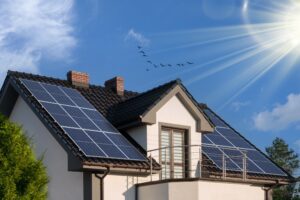Have your energy consumption levels been on the rise and are you looking for ways to reduce your energy bills? You may wish to install cavity wall insulation to gain access to the various benefits that come along with this energy efficiency method, which includes: reduced energy bills, lower carbon footprint, less risk of draughts in your home, and greater noise cancellation indoors.
While there are many pros related to cavity wall insulation, there are also a few issues. This article will delve into what cavity wall insulation is, how you can find out whether you have cavity walls, and the types of insulation available. Additionally, we will inform you as to what the most common cavity wall insulation problems are, and how long cavity insulation is likely to last.
What Is Cavity Wall Insulation?
Cavity wall insulation is quite simply the process of installing insulation material (of which there are a variety of options) into your wall cavity. The cavity is located in the gap between the outer walls and internal walls of your property. However, not all properties in the UK have been built with cavity walls.
How Do I Know If I Have Cavity Walls?
Most houses in the UK are either built with cavity walls or solid walls. If you are uncertain as to which wall type your property has, there are four easy checks you can complete to find out. These are:
- Check when your property was built – Properties built before the 1920s more than likely were constructed using solid walls. This is because building regulations changed during this period, and cavity walls became more popular.
- Inspect your property’s brick pattern – If the bricks of your property were laid in an even pattern with all bricks placed lengthways, this is a clear sign of cavity walls. Alternatively, you may notice an uneven pattern with a mixture of brick lengths, which will mean you have solid walls.
- Measure your wall thickness – If you are unable to see your brick pattern, perhaps you have insulation installed on your exterior walls or rendering covering it, then you can always measure the thickness of your walls. Walls that measure greater than 260mm probably have built-in cavities.
- Research your EPC rating – Most residential properties in the UK will have received an Energy Performance Certificate (EPC) rating. These ratings relate to your property’s energy efficiency level. If your property has a higher rating, there’s a greater chance that you already have cavity wall insulation installed.
Types Of Insulation Material
For those households that have cavity walls and wish to insulate them, there are a variety of insulation methods available on the market that can be used. Each method comes with its pros and cons and fulfils different requirements at various price points.
- Polyurethane foam.
- Polystyrene beads.
- Urea formaldehyde foam (also known as spray foam insulation).
- Mineral wool (can also be combined with insulation boards to provide internal wall insulation).
- Cavity batts.
Work with Effective Home if you’re looking to install cavity wall insulation in your home.
Most Common Cavity Wall Insulation Problems
Similar to any other home improvement process you may embark on, the pros and cons are surrounding the installation of cavity wall insulation. While there are a variety of insulating materials available, as we have previously discussed, there is no method that is 100% safe from suffering an issue.
Below, we have listed the top five cavity wall insulation problems that you can suffer if you choose to purchase this energy-efficiency method.
1. Insulation Efficiency Levels Diminish If Installed Incorrectly
The most prevalent of all cavity wall insulation problems is if your insulation is installed incorrectly. This can usually happen when individuals install their insulation themselves, or when professionals have not taken the proper care. The following issues that we will list below all stem from a poor installation process. If your insulation isn’t installed properly, it can lead to any of these issues:
- Uneven cavity wall insulation can lead to the development of cold bridging.
- Lower energy efficiency levels.
- The development of dampness, mould, or condensation.
- Damaged brickwork or structural issues.
- You may even need to consider cavity wall insulation removal, depending on how badly your cavity wall insulation has been installed.
The best prevention here is to work with expert installers like ours at Effective Home.
2. The Potential For Damp Cavity Wall Insulation
One of the biggest issues that can arise from poorly installed cavity wall insulation is the development of damp problems. Whether it is the use of poor insulation materials or the insulation being poorly installed, if your cavity wall insulation fails it can lead to moisture penetration. The worst-case scenario is that these damp areas could lead to black mould growth.
Development Of Cold Spots
When insulation is installed incorrectly, it could lead to the insulation not covering the entirety of the wall cavity. Where there is no insulation, your walls will develop cold spots. These areas will become increasingly more vulnerable to damp patches because condensation will more than likely develop in that location.
3. Retrofitting Insulation In Cavity Walls
As we have briefly mentioned, not all properties are suitable for cavity wall insulation. Older properties, or properties with smaller wall cavities, are more likely to suffer cavity wall insulation problems if installers attempt to inject any insulating material in the available gap.
If you choose to retrofit cavity wall insulation in your property, then you should consider reading the Building Research Establishment (BRE) report on the drawbacks of installing cavity wall insulation in retrofitting circumstances. It gives you a detailed breakdown of the various problems you could face, so it will provide you with a full picture of what retrofitting cavity wall insulation could look like for you.
Issues For Older Properties With Exterior Wall Cracks
The older your property is, the greater the likelihood that it may suffer from wall cracks. These present major problems with cavity wall insulation, as damage to the external walls allows for a greater chance of water penetration.
While all insulation materials will be damaged if an external wall cannot withstand severe weather conditions, mineral wool and cavity batts will be even more vulnerable. This is because if rainwater penetration were to occur, these two types of insulation material are more likely to absorb moisture compared to others on the market. If this were to happen, then the insulation method would cease to be effective.
4. Insulation Materials Could Damage Your Property
The insulation materials used during the installation process may cause problems without them being either poor quality or outdated. If your insulation materials were to clump, overbond, or shrink within the cavity walls, this could cause extensive issues relating to the wall ties located in cavity walls.
In instances where cavity insulation is at risk of causing structural issues, or has been installed incorrectly, you may need to opt to have your cavity wall insulation removed. Additionally, insulation installers may also have to remove over-bonded beads, if you choose to have polystyrene beads, as these too can cause structural damage to your property as they are attached to your walls using a bonding agent.
Always work with fully trained professionals when having cavity wall insulation installed to avoid these problems.
Beware Of Cold Bridging
Aside from the structural damage that the clumping or over-bonding of insulation materials may cause, these processes also increase the possibility of cold bridging occurring in the cavity walls. Cold bridging refers to the creation of gaps where there is no insulation in the cavity, which can cause the cold spots mentioned above.
5. Risk Of Inadequate Ventilation
Cavity wall insulation aims to minimise the amount of airflow that can occur within the cavity of your walls. However, as a result of this, you will need to install additional ventilation in your property to limit the risk of dampness and condensation in your home. This integral part of the installation process can be overlooked if the company you work with doesn’t prioritise proper airflow and ventilation in your home whilst planning your insulation installation.
How Long Does Cavity Wall Insulation Last?
Unlike other energy efficiency methods, cavity wall insulation does not come with a specified lifespan. Instead, insulation experts state that any type of cavity wall insulation will last the entire lifespan of your property when installed properly.
What Is The Cavity Insulation Guarantee Agency?
The Cavity Insulation Guarantee Agency (CIGA) aims to provide consumers with greater peace of mind. They aim to achieve this by offering customers who purchase any type of cavity wall insulation a prolonged warranty to protect their purchase.
Even though cavity wall insulation aims to last the lifetime of your property, they will also give you a 25-year warranty that will start after installation. This warranty will protect you if you were to suffer any of the issues we have mentioned above, as long as they occur during the period that the warranty lasts.
At Effective Home we don’t work with CIGA, but we are part of the HIES and QualityMark Protection schemes, which offer a 25-year warranty on all our cavity wall insulation installations and are also a mark of our professionalism within the industry.
Cavity Wall Insulation Problems Summary
If you are looking for ways to improve your home’s energy efficiency levels, then installing cavity wall insulation is a brilliant option. From reduced energy bills and a minimised carbon footprint to a more comfortable house and less noise pollution, there are plenty of benefits related to cavity wall insulation.
On the other hand, however, there are also various cavity wall insulation problems that you should also take into consideration. These include:
- Installation issues.
- Risk of cold bridging, dampness, condensation, and mould.
- Potential damage to your property’s structural integrity.
- External wall cracks.
- Inadequate ventilation added to your house post installation.
If you want to find out more about cavity wall insulation, then why not get in touch with Effective Home? Our insulation experts can answer any questions you may have and get you started on the installation process.



